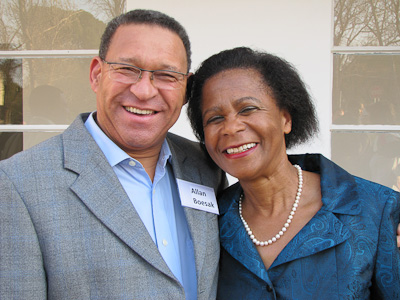 |
Pictured are: Dr Boesak and Dr Ramphele
Photo: Mangaliso Radebe |
The University of the Free State (UFS) could well be a perfect model of excellence in race relations that the whole of South Africa could emulate.
This was said by Dr Mamphela Ramphele, the first African to be a Managing Director of the World Bank, during the Anti-Racism Network in Higher Education (ARNHE) Colloquium held at the UFS recently.
“Healing circles need to be constructed on this campus to address issues raised by the Reitz incident,” she said.
“You might yet be the pioneer of what needs to happen on a nation-wide level.
“Can we confidently commit today to go on this quest for a true humanity and walk together as fellow citizens and strive for a more human face for our society? That is our challenge. That is what the UFS is called to give leadership to.”
“It is this human face which has the power to liberate us from the body of death and strengthen us in our struggle for meaningful life together in South Africa,” added one of the main speakers, Dr Allan Boesak, a cleric and former anti-apartheid activist.
However, said Dr Ramphele, this could only be achieved if all South Africans, black and white, abandoned the fear for each other that was hindering, if not stalling, progress in this regard.
“Fear of each other is the most important impediment to the sustainability of our journey into a society united in our diversity,” she said.
“People in this country are afraid to stand up and be counted, including many vice-chancellors and clerics. They are afraid of being seen to be difficult, and that is a major problem. Fear is the most destructive emotion that you can have because it makes you really incompetent and unable to respond to challenges.”
She said the biggest impediment, though, to ending racism was denial. “White people deny vehemently that they are or have ever been racist,” she said.
“We need to go through a process of acknowledging our wounds and scars from our racist past and present missteps in public policy.”
“Instead of saying they are sorry, those who are conscious of their whiteness should rather say what they are sorry for,” said another main speaker, Prof. Dennis Francis, the Dean of the Faculty of Education at the UFS.
On the other hand, according to Dr Boesak, blacks were and still are, to a large extent, also to blame for their own ongoing oppression. “The key here was the acknowledgement of our sheepish timidity, our complicity,” he said.
The Chairperson of ARNHE, Prof. Norman Duncan, had this to say: “If we are to confront and eradicate racism in higher education institutions, we should not do so to create comfort zones for ourselves.”
The theme of this ARNHE Colloquium was Black consciousness and those conscious of their whiteness. It was presented by the International Institute for Studies in Race, Reconciliation and Social Justice at the UFS.
Media Release:
Mangaliso Radebe
Assistant Director: Media Liaison
Tel: 051 401 2828
Cell: 078 460 3320
E-mail: radebemt@ufs.ac.za
6 August 2010